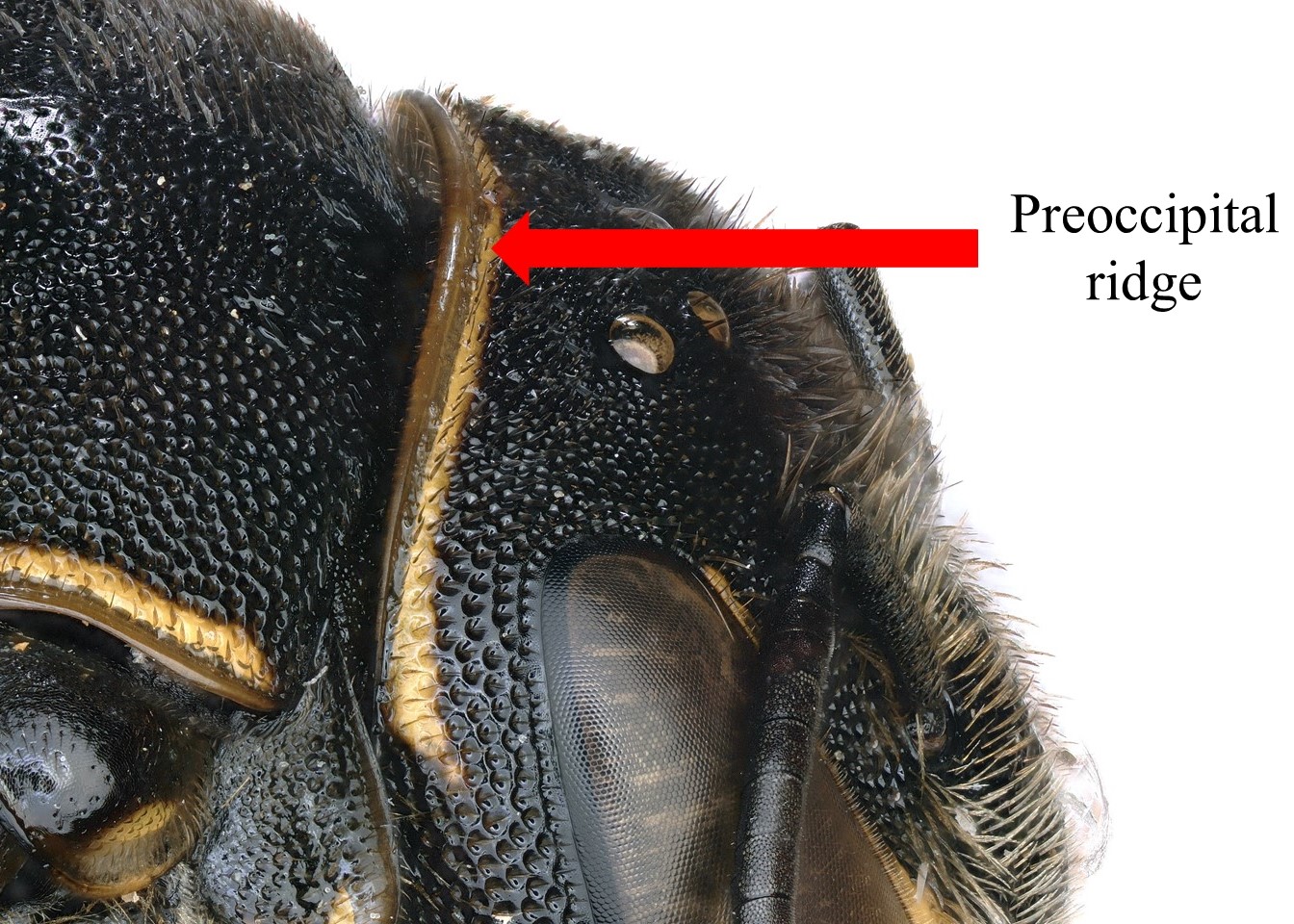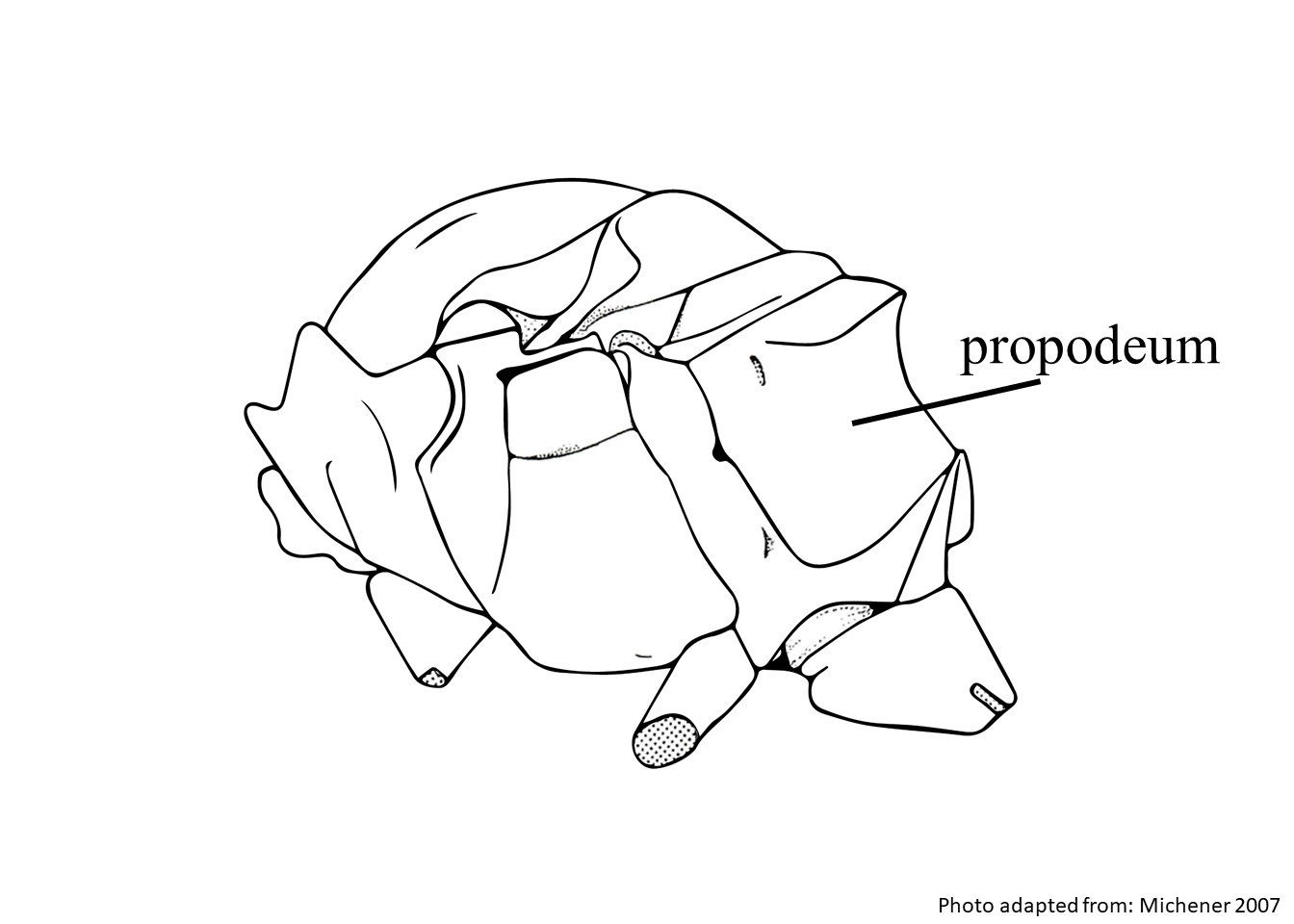Taxonomy
Family: Megachilidae
Subfamily: Megachilinae
Tribe: Anthidiini
Genus: Aztecanthidium Michener and Ordway, 1964
Subgenera: none
Common name: none
Overview
Aztecanthidium have a somewhat elongate, parallel-sided body. They range in body length from 11–21 mm. They are either black with yellow maculations on their head and body, or almost entirely reddish-brown (Snelling 1987Snelling 1987:
Snelling, R.R. 1987 A revision of the bee genus Aztecanthidium (Hymenoptera: Megachilidae). Pan-Pacific Entomologist 63: 165ndash;171.).
Diversity
Aztecanthidium contains 3 species worldwide (
Snelling 1987Snelling 1987:
Snelling, R.R. 1987 A revision of the bee genus Aztecanthidium (Hymenoptera: Megachilidae). Pan-Pacific Entomologist 63: 165ndash;171.); none are known to occur in the U.S. or Canada.
Diagnostic characteristics
(modified from Michener and Ordway 1963Michener and Ordway 1963:
Michener, C.D. and E. Ordway. 1963. Some anthidiine bees from Mexico (Hymenoptera: Megachilidae). New York Entomological Society 72: 70ndash;78.)
- Arolia present.
- Juxtantennal carinacarina:
a clearly defined ridge or keel, not necessarily high or acute; usually appears on bees as simply a raised line
present.
- Omaular carinacarina:
a clearly defined ridge or keel, not necessarily high or acute; usually appears on bees as simply a raised line
present but weak.
- Preoccipital ridge preoccipital ridge:
the carina that dorsolaterally surrounds the back of the head
 strongly carinatecarinate:
strongly carinatecarinate:
having keels or carinae
all the way to the hypostomalhypostomal:
the notched region underneath the head and behind the mandible that holds the folded tongue
 carinae.
carinae.
- Pronotal lobe pronotal lobe:
a part of the pronotum located dorsally on the posterior margin of the pronotum and overlaps the anterior thoracic spiracle
 carinatecarinate:
carinatecarinate:
having keels or carinae
.
- Propodeum propodeum:
the last segment of the thorax
 without foveafovea:
without foveafovea:
a depressed region of cuticle; in bees this depressed area is usually only very slightly hollow and usually on the face.
defined by a carinacarina:
a clearly defined ridge or keel, not necessarily high or acute; usually appears on bees as simply a raised line
behind spiraclespiracle:
a breathing pore, usually occurring on the third thorasic segment
.
- Scutellum scutellum:
shield shaped plate behind scutum
 bituburculate.
bituburculate.
- Female T6T6:
the segments on the top side of the abdomen, often abbreviated when referring to a specific segment to T1, T2, T3, T4, T5, T6, or T7
 with strong sub-lateral teeth.
with strong sub-lateral teeth.
- Male T5T5:
the segments on the top side of the abdomen, often abbreviated when referring to a specific segment to T1, T2, T3, T4, T5, T6, or T7
 and T6T6:
and T6T6:
the segments on the top side of the abdomen, often abbreviated when referring to a specific segment to T1, T2, T3, T4, T5, T6, or T7
 with strong laterallateral:
with strong laterallateral:
relating, pertaining, or attached to the side
tooth.
- Male T7T7:
the segments on the top side of the abdomen, often abbreviated when referring to a specific segment to T1, T2, T3, T4, T5, T6, or T7
 bilobed.
bilobed.
May be confused with
Aztecanthidium resembles bees in the genus Notanthidium in its size, color, and parallel-sided shape, but Notanthidium lacks juxtantennal and preoccipital carinae and does not possess the laterallateral:
relating, pertaining, or attached to the side
teeth on T5T5:
the segments on the top side of the abdomen, often abbreviated when referring to a specific segment to T1, T2, T3, T4, T5, T6, or T7
 or T6T6:
or T6T6:
the segments on the top side of the abdomen, often abbreviated when referring to a specific segment to T1, T2, T3, T4, T5, T6, or T7
 that are present in Aztecanthidium.
that are present in Aztecanthidium.
Known invasives
There are no known invasives.
Host associations
Floral associations are unknown.
Nesting behavior
Nesting behavior is unknown.
Distribution
Aztecanthidium is restricted to central Mexico, from the states of Puebla and Nayarit south to Oaxaca (Michener 2007Michener 2007:
Michener, C.D. 2007. The Bees of the World (2nd ed.). Johns Hopkins University Press, Baltimore and London, 953 pp.).

Distribution map generated by Discover Life -- click on map for details, credits, and terms of use.
References
Michener, C.D. and E. Ordway. 1963. Some anthidiine bees from Mexico (Hymenoptera: Megachilidae). New York Entomological Society 72: 70-78.
Michener, C.D. 2007. The Bees of the World (2nd ed.). Johns Hopkins University Press, Baltimore and London, 953 pp.
Snelling, R.R. 1987 A revision of the bee genus Aztecanthidium (Hymenoptera: Megachilidae). Pan-Pacific Entomologist 63: 165-171.
 strongly carinatecarinate:
strongly carinatecarinate: with strong sub-lateral teeth.
with strong sub-lateral teeth. and T6T6:
and T6T6: with strong laterallateral:
with strong laterallateral: bilobed.
bilobed. or T6T6:
or T6T6: that are present in Aztecanthidium.
that are present in Aztecanthidium.